Species of concern
Species of concern are native species, sub-species or ecologically significant units that warrant special attention to ensure their conservation. The number of species of concern within the Salish Sea is used by the US Environmental Protection Agency and Environment Canada as a transboundary ecosystem indicator (called "Marine Species at Risk").
Source
OVERVIEW
The growing number of species of concern in the Salish Sea suggests ecosystem decay is outpacing recovery
The number of species of concern in the Salish Sea is growing at an average annual rate of 2.6%, according to a report published in the proceedings of the 2016 Salish Sea Ecosystem Conference in Vancouver, B.C.
RELATED ARTICLES
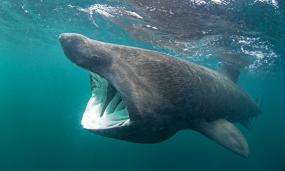
Will these gentle giants return to the Salish Sea?
A shark species the length of a bus was once common in the Salish Sea. Then it was labeled a "destructive pest" and nearly wiped out. Can the gentle and often misunderstood basking shark make a comeback?
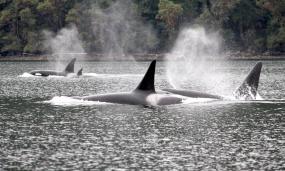
Under a new proposal, our local orcas — resident and Bigg’s killer whales — would each become a new species
A scientific paper, published on March 27th, spells out the unique physical and genetic characteristics that should make each group a separate species, with the proposed scientific names Orcinus ater for residents and Orcinus rectipinnus for Bigg’s.
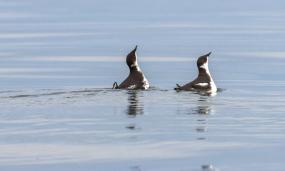
Science notebook: Winter studies of Puget Sound's threatened marbled murrelets
For years now, scientists have been braving the cold winter waters of Puget Sound to study one of the region's most enigmatic seabirds, the marbled murrelet. Listed as threatened under the Endangered Species Act in Washington, Oregon, and California, marbled murrelets nest in old-growth forests but find their food at sea. Much research on the birds has centered around the spring and summer breeding season, but less is known about what the murrelets do in winter. That puzzle prompted a team of scientists from the Washington Department of Fish and Wildlife to head out on the water last January. Writer and biologist Eric Wagner joined the expedition and brought back these notes from the field.
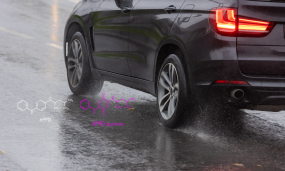
Lawsuits fly, as regulators come to grips with a toxic tire chemical
Finding a replacement for 6PPD in tires is one major challenge; another is to prevent the highly toxic derivative 6PPD-Q from reaching salmon streams and killing fish.
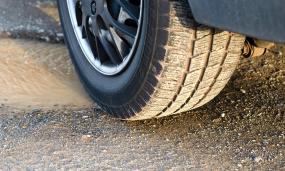
Scientists worldwide are immersed in studies of a deadly tire chemical
Research that began in Puget Sound has revealed much about the cellular-level assault on vulnerable salmon and trout, yet the puzzle remains incomplete.
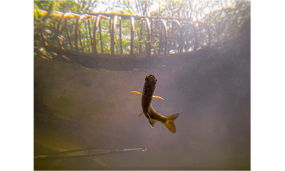
Photographing the 'Creek of Hope'
Longfellow Creek near West Seattle's industrial district still draws spawning salmon despite a century of city development and an onslaught of toxic chemicals. A current exhibit by photographer Tom Reese explores this often-overlooked gem of urban nature.
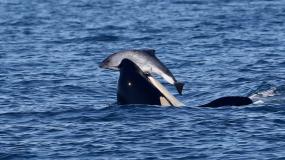
Southern resident orcas chase and sometimes kill porpoises. Why don’t they eat them?
Puzzling encounters between endangered killer whales and harbor porpoises point to questions about prey availability and whale culture, scientists say. Are the whales playing, practicing their hunting skills, or is something else going on?

Dispatch from the last colony
Tufted puffins have become an increasingly rare sight in the Pacific Northwest. Biologist and writer Eric Wagner recently visited Puget Sound's Smith Island, home to one of the region's last surviving colonies of these colorful seabirds.
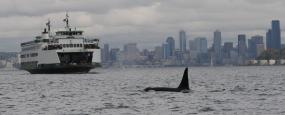
Inbreeding hinders population recovery among endangered Southern Resident killer whales
While a scarcity of Chinook salmon and other environmental factors may be pushing the Southern Resident killer whales toward extinction, a new genetics study has revealed that inbreeding has been exerting a powerful, overriding influence upon the small, genetically isolated population.

Four years after Tahlequah's journey, the legal and ethical debates over orca protection continue to evolve
It has been four summers since a mother orca’s dramatic vigil brought worldwide attention to the plight of Puget Sound’s southern resident killer whales. A recent gathering of legal experts, conservationists, and academic scholars looked at how perceptions of the whales have changed since then and whether laws and policies should reflect new thinking about ethical responsibilities to orcas and other animals.

Returning home: The Elwha's genetic legacy
Following dam removal, migratory salmon have been free to swim into the upper Elwha River for the first time in 100 years. Their actual behaviors and reproductive success may well be driven by changes in their genetic makeup. Our seven-part series 'Returning home' examines how the fish are doing and whether the Elwha's genetic legacy remains intact.
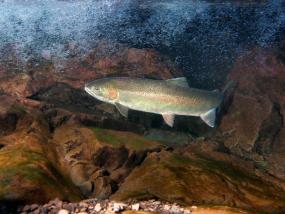
Wild steelhead still a force in the Elwha
Migration patterns have apparently reawakened for the Elwha River's wild steelhead. Studies show that the fish may have retained much of their genetic drive despite 100 years of being trapped behind dams. We continue our series 'Returning home: The Elwha's genetic legacy' with part two of seven.
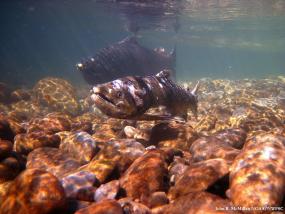
Will the mighty spring Chinook rise again?
Our series 'Returning home: The Elwha's genetic legacy' continues with a look at the possible return of spring Chinook to the upper portions of the Elwha River. We bring you part three of seven.
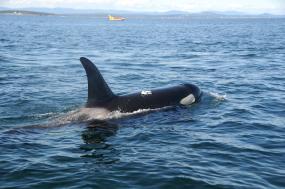
Placing microphones on orcas offers a point-of-whale perspective on underwater noise
Research on the sounds and feeding behavior of Puget Sound's southern resident orcas is providing new insight into how the whales respond to underwater noise. A recent online conference brought together some of these findings along with discussions on how to reduce the impacts of noise from vessel traffic.
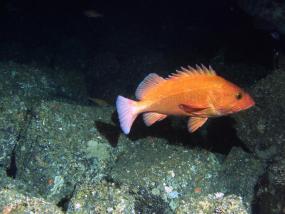
Are yelloweye rockfish on the path to recovery?
New research suggests that recovery efforts are working for Puget Sound’s threatened yelloweye rockfish. Preliminary models show "considerable improvement" in population numbers.

Learning from a legacy of overfishing
Fishing for rockfish was once promoted as a sustainable alternative to salmon harvests, but when rockfish numbers plummeted, fisheries managers realized they had a problem. Now a rockfish recovery plan seeks to reverse the damage as scientists learn more about protecting this once-popular game fish.
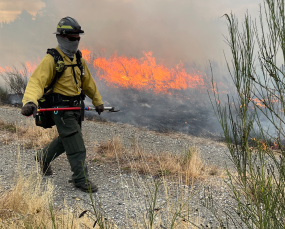
Controlled burn in Puget Sound prairie habitat
Raging wildfires can be an ecological disaster, especially as the planet warms due to climate change. But in small doses, some wildfires are actually beneficial. In prairie habitats, fires can enrich soils and maintain native plant species. In late September, state wildlife biologists oversaw several controlled burns near Joint Base Lewis-McChord (JBLM) as part of an effort to preserve habitat for the endangered Taylor's checkerspot butterfly. Less than 3% of Puget Sound's prairies now remain and are mostly concentrated along the region's southern edges, including land on the military base. Listen to a recording of some of the action, including comments from JBLM fire manager and biologist John Richardson.

Taking the temperature of salmon
Warming waters threaten the recovery of salmon in Puget Sound. New findings about stream temperature could help salmon survive the threats of climate change.

"Sounders" arrive as gray whales decline along the coast
Each spring, about a dozen gray whales make a brief detour into the Salish Sea before heading north to their feeding grounds in the Arctic. Biologists dubbed these whales "Sounders" after first noting their presence in the 1990s, and the whales have become rare but widely anticipated visitors to local waters. The whales were spotted again this year, but biologists have documented a 24 percent decline in gray whale populations along the West Coast.
Chinook Salmon Implementation Strategy
This article provides an overview and a link to further information about the Chinook Salmon Implementation Strategy. Implementation Strategies (Strategies) are plans for accelerating progress toward the 2020 ecosystem recovery targets for the Puget Sound Vital Signs. The Strategies are developed collaboratively with technical, professional, and policy experts and with local and regional input. They are funded by the Environmental Protection Agency.
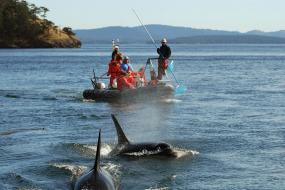
Southern residents’ winter diet comes into focus
A 2021 paper in the journal PLoS ONE provides a clearer picture of what endangered southern resident orcas eat throughout the year. Chinook salmon make up the bulk of the whales' diet, but the paper suggests that other salmon species and non-salmonid fishes can also play important roles depending on the season.
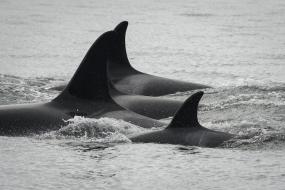
Killer whale CSI
Collisions with boats and other interactions with humans are "significant" causes of death for killer whales in the northeastern Pacific, a recent study says. The findings come from one of the most comprehensive looks at killer whale pathology to date, but scientists say determining how a killer whale may have died is often notoriously difficult.
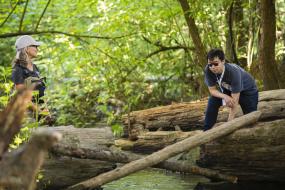
Timeline: The search to find a chemical that kills coho salmon in urban streams
The search for why large numbers of spawning coho salmon have been dying in Puget Sound's urban streams goes as far back as the 1980s and culminated this year with the discovery of a previously unidentified chemical related to automobile tires. We offer a detailed timeline for the discovery.
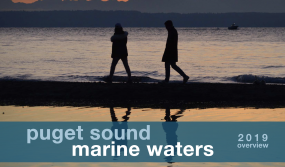
2019 Puget Sound Marine Waters Overview
A new report from the Puget Sound Ecosystem Monitoring Program details the effects of a changing climate on Puget Sound in 2019, and documents how these changes moved through the ecosystem to affect marine life and seafood consumers.
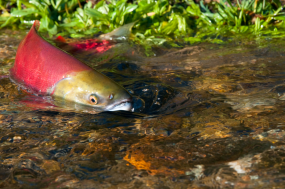
Disease may play significant role in salmon declines
Few environment problems in the Salish Sea have been studied more than the steep decline in salmon populations. But one potential contributor to these declines has gained less attention. Scientists say infectious disease may play a wider role than previously understood.
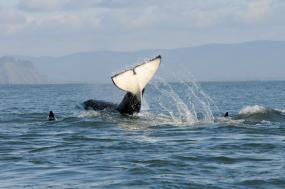
Orcas without borders
The Salish Sea’s endangered southern resident orcas travel freely across the U.S.-Canada border, unconstrained by political boundaries. But while they don’t require passports, they can still face differing policies and conditions as they go back and forth between nations. We look at some of the ways that the United States and Canada compare in their efforts to protect the whales.

Delicious and now endangered: Can the pinto abalone make a comeback?
The pinto abalone was a popular sport catch for divers in the Salish Sea until its numbers plummeted to near extinction. Now, the delicious marine snail is on the endangered species list and the focus of an ambitious hatchery and replanting program. A broad coalition of partners has released more than 20,000 young pintos into the wild with the hope that the population will start to rebound.
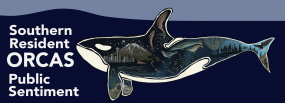
Social scientists analyze public reactions to orca crisis
Social scientists at Oregon State University have been analyzing a trove of more than 17,000 public comments sent to the Washington state governor's southern resident orca recovery task force. The researchers have added the comments to a keyword database to look at public emotions and perceptions around the issue of orca declines.

Virus related to measles could push Puget Sound orcas to extinction, study says
Researchers studying the killer whales that frequent Puget Sound are growing increasingly concerned that a dangerous virus or other disease-causing organism could spread through the population and hasten extinction of these critically endangered southern resident orcas.
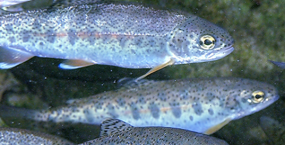
Warming ocean conditions fuel viruses among species in the Salish Sea
As officials struggle to track and contain the outbreak of the novel coronavirus known as COVID-19, ecologists say widespread impacts from viruses and other pathogens are also a growing threat to the species of the Salish Sea ecosystem.

Puget Sound's 'warm snow’ makes region vulnerable to climate shifts
Climate models project that if carbon emmisions continue as they are now, the vast majority of watersheds feeding Puget Sound will receive more rain and far less snow by 2080, causing increased flooding and other dramatic changes to the freshwater ecosystem. We look at the past and possible future of the region's snowpack and what this might mean for salmon and other species — including humans.
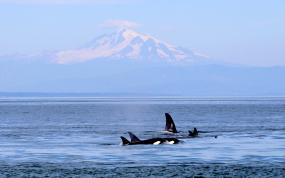
Social networks a key to orca survival
Understanding the social networks and family bonds of Puget Sound's southern resident orcas may be critical to keeping the endangered whales from extinction. A healthy population is about more than numbers, scientists say. It's about connections.
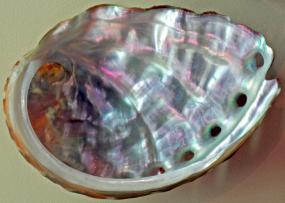
The survival of hatchery‐origin pinto abalone Haliotis kamtschatkana released into Washington waters
In Washington State, the pinto abalone (Haliotis kamtschatkana) has declined by 97 percent since 1992 and is unlikely to recover without intervention. A captive rearing and restocking pilot study shows promise for saving wild populations from local extinction.
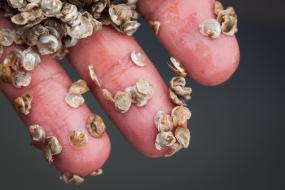
Return of a native: Olympia oysters are making a comeback
Puget Sound’s only native oysters were nearly wiped out in the 19th century from overharvesting. Now a network of scientists and advocates is working to restore them to their historical and cultural prominence.
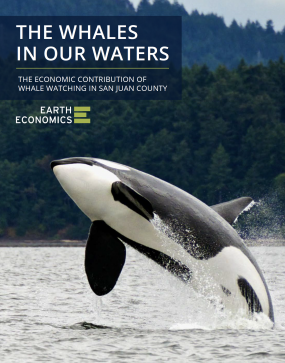
The whales in our waters: The economic contribution of whale watching in San Juan County
A 2019 report from the non-profit group Earth Economics look at revenues and other economic activity resulting from whale watching in San Juan County, Washington.
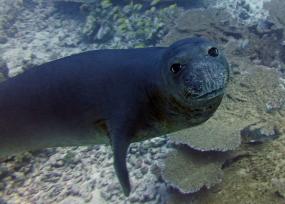
Vaccines now used to reduce the risk of extinction in Hawaiian monk seals
For critically endangered animal populations, experts worry that a highly infectious disease could be the final nail in the coffin, forcing the species into extinction. That’s one reason why federal authorities approved the development and deployment of a new vaccine to ward off the deadly morbillivirus among Hawaiian monk seals. The vaccination program raises the possibility of using vaccines to prevent disease among Puget Sound's southern resident killer whales, but no specific steps have been taken so far.

When should medical experts intervene to save a killer whale?
The death of a young female orca in September has sparked a discussion of how and whether scientists should step in with medical care for distressed animals in the wild. Medical intervention has become routine for some endangered mammals, but scientists say Puget Sound’s resident orcas present a series of unique challenges and ethical questions. In part one of our two-part series The Orca Docs we look at how scientists are preparing to treat endangered southern resident orcas that face starvation and risks of disease.

Respecting the rockfish of the Salish Sea
Puget Sound's rockfish have declined by 70% over the past few decades, prompting state and federal protection efforts. We look at some of the ways that scientists are working to reverse the fish's downward trend.

For declining orcas, food is fate
Recent images of a mother orca appearing to grieve for her dead calf have brought worldwide attention to the plight of Puget Sound’s endangered Southern Resident orcas. As orca numbers decline, we look at how the effects of toxic chemicals on the whales are magnified even as the residents slowly starve from a general lack of Chinook salmon, their chief source of food.

Marine survival: New clues emerging in salmon deaths
An intensive research program in the U.S. and Canada is studying why so few salmon in the Salish Sea are returning home to spawn. It is uncovering a complex web of problems involving predators, prey and other factors that put salmon at risk as they migrate to the ocean. We present a four-part series on the Salish Sea Marine Survival Project, including new findings presented at the 2018 Salish Sea Ecosystem Conference last spring in Seattle.
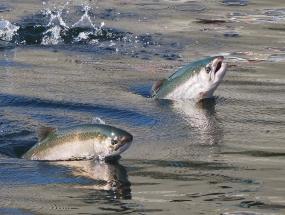
New studies on emerging threats to salmon
Chemicals, disease and other stressors can increase a salmon's chance of being eaten or reduce its ability to catch food. We wrap up our series on the Salish Sea Marine Survival Project with a look at some of the lesser-known, but still significant factors contributing to salmon declines in the Salish Sea.
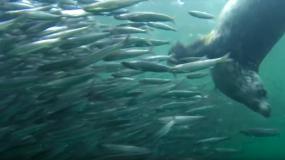
Could anchovies and other fish take pressure off salmon and steelhead?
A recent influx of anchovies into Puget Sound may have saved some steelhead from predators, but researchers seek more evidence to prove the connection. Our series on the Salish Sea Marine Survival Project continues with a look at these and other potential impacts from predators on the region's salmon and steelhead.
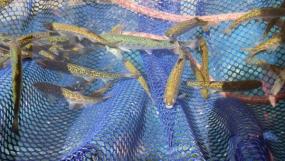
Size means survival for young salmon
Getting bigger faster can help save juvenile Chinook salmon from a gauntlet of hungry predators ranging from birds and marine mammals to larger fish. We continue our series on the Salish Sea Marine Survival Project with a look at what helps salmon grow and prepare for life in the open ocean.
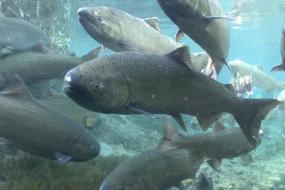
Opening the black box: What’s killing Puget Sound’s salmon and steelhead?
An intensive research program in the U.S. and Canada is studying why so few salmon in the Salish Sea are returning home to spawn. They are uncovering a complex web of problems involving predators, prey and other factors that put salmon at risk as they migrate to the ocean. We begin a four-part series on the Salish Sea Marine Survival Project, including new findings presented at the 2018 Salish Sea Ecosystem Conference last spring in Seattle.
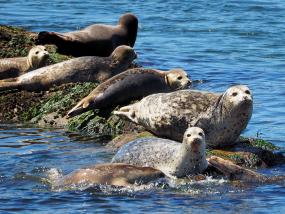
Study would explore changes to protections for seals and sea lions
As wildlife managers work to recover Puget Sound’s diminished Chinook population, a proposed white paper is expected to review the impacts of some of the salmon's chief predators. The study would include a section on potential management of seals and sea lions, prompting open discussion of a long taboo subject: Could officials seek to revise the Marine Mammal Protection Act — or even conduct lethal or non-lethal removal of seals and sea lions in some cases? Such actions are hypothetical, but we look at some of the ongoing discussions around the issue as prompted by a new resolution from the Puget Sound Leadership Council.
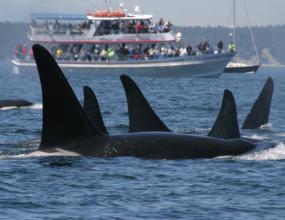
Soundwatch: Eighteen years of monitoring whale watch vessel activities in the Salish Sea
A December 2017 article in the journal PLOS One reports that incidents and violations among whale watching vessels have increased in the Central Salish Sea since 1998.
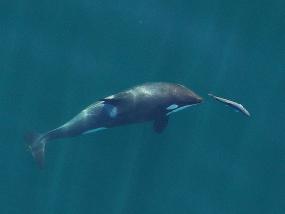
Seals and sea lions may be slowing salmon recovery, hurting orcas
Increased consumption of Chinook salmon by seals and sea lions in the Salish Sea “could be masking the success of coastwide salmon recovery efforts,” according to a new study published in the journal Scientific Reports. Endangered resident orcas are said to be declining in part due to a lack of available Chinook, the orcas' preferred prey.
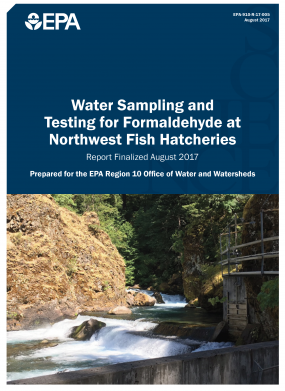
Water sampling and testing for formaldehyde at Northwest fish hatcheries
Formaldehyde is often used to control parasites on hatchery salmon and trout. The U.S. Environmental Protection Agency and the Washington State Department of Ecology conducted a joint study of formaldehyde concentrations in effluent from hatcheries in the Pacific Northwest.
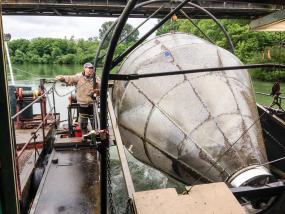
Are we making progress on salmon recovery?
In recent decades, hundreds of millions of dollars have been spent to restore habitat for Puget Sound salmon. In this article, we look at how scientists are gauging their progress. Are environmental conditions improving or getting worse? The answer may depend on where you look and who you ask.
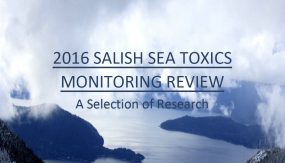
2016 Salish Sea toxics monitoring review: A selection of research
A 2017 report from the Puget Sound Ecosystem Monitoring Program presents an overview of selected recent monitoring and research activities focused on toxic contaminants in the Salish Sea.

Puget Sound Ecosystem Monitoring Program
The Puget Sound Ecosystem Monitoring Program (PSEMP) is an independent program established by state and federal statute to monitor environmental conditions in Puget Sound.
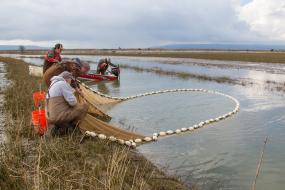
Finding a strategy to accelerate Chinook recovery
As threatened Chinook populations in Puget Sound continue to lose ground, the state is looking to new strategies to reverse the trend. In the Skagit watershed, the scientists — and the fish — are among those leading the way.
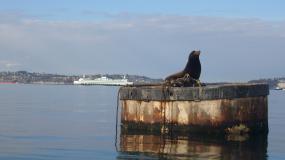
Study says predators may play major role in chinook salmon declines
A new study shows that increased populations of seals and sea lions are eating far more of Puget Sound’s threatened chinook than previously known, potentially hampering recovery efforts for both salmon and endangered killer whales.
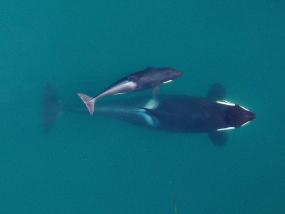
Killer whale miscarriages linked to low food supply
New techniques for studying orcas have been credited with breakthroughs in reproductive and developmental research. Drones and hormone-sniffing dogs are helping scientists connect declines in food supply with low birth rates and poor health. Update: The research described in this 2016 article has now been published in the 6/29/17 issue of the journal PLOS ONE.
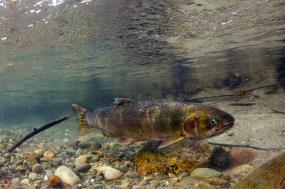
Advances in technology help researchers evaluate threatened Puget Sound steelhead
New, smaller acoustic tags will allow scientists to track steelhead migrations in Puget Sound in ways that were once impossible. Will they provide answers to the mysterious decline of these now-threatened fish?
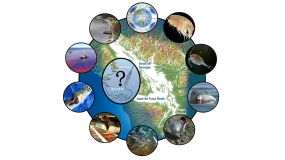
Mystery remains in deaths of young salmon
The Salish Sea Marine Survival Project has mobilized dozens of organizations in the U.S. and Canada to find an answer to one of the region's greatest mysteries. What is killing so many young salmon before they can return home to spawn? A series of talks at the 2016 Salish Sea Ecosystem Conference brought together some of the latest research.
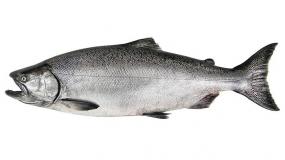
Contaminants higher in resident 'blackmouth' Chinook
Many of Puget Sound's Chinook salmon spend their entire lives in local waters and don't migrate to the open ocean. These fish tend to collect more contaminants in their bodies because of the sound's relatively high levels of pollution.
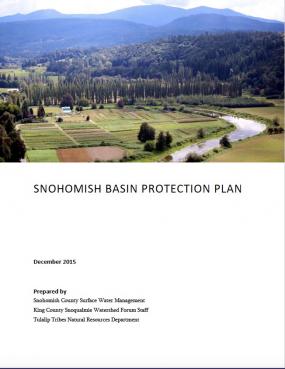
Snohomish Basin Protection Plan
A 2015 report from Snohomish County, King County and the Tulalip Tribes outlines protection strategies for salmon and salmon habitat within the Snohomish Basin.
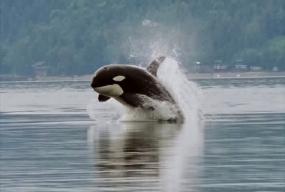
New theory rethinks spread of PCBs and other toxics in Puget Sound
Researchers are proposing a shift in thinking about how some of the region’s most damaging pollutants enter Puget Sound species like herring, salmon and orcas.
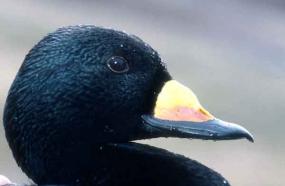
Conference snapshot: The number of species of concern in the Salish Sea is growing steadily
The number of species of concern in the Salish Sea is growing at an average annual rate of 2.6%, according to a report published in the proceedings of the 2016 Salish Sea Ecosystem Conference in Vancouver, B.C.

Contaminants of emerging concern in a large temperate estuary
A 2016 paper in Environmental Pollution identifies dozens of pharmaceuticals and other compounds that are accumulating in Puget Sound fish such as salmon.
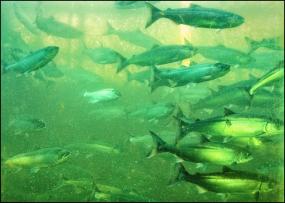
Salmon live in a topsy-turvy world upstream of the Ballard Locks
Chinook, coho and sockeye salmon, along with steelhead trout, live in the Lake Washington watershed and navigate a treacherous route through the Ballard Locks on their way to Puget Sound.
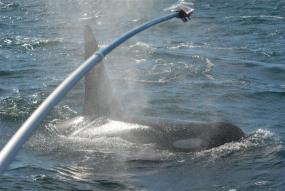
Concerns rise over potential impacts of disease on the ecosystem
From orcas to starfish to humans, disease affects every living creature in the ecosystem. Scientists are increasingly alarmed by its potential to devastate already compromised populations of species in Puget Sound.
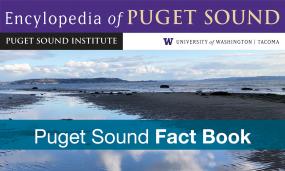
Puget Sound Fact Book
The Puget Sound Fact Book brings together statistics and other information about the health and makeup of the Puget Sound ecosystem. Areas of focus include climate change, geography, water quality, habitats, human dimensions and regional species. The fact book was prepared for the Encyclopedia of Puget Sound with funding from the Environmental Protection Agency and the Puget Sound Partnership.
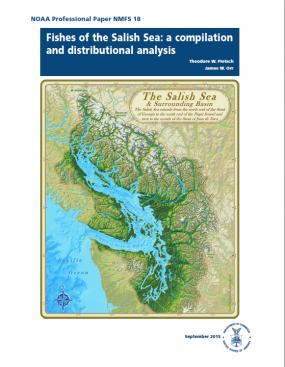
Fishes of the Salish Sea: a compilation and distribution analysis
A 2015 NOAA report creates an updated and comprehensive list of the fishes of the Salish Sea.
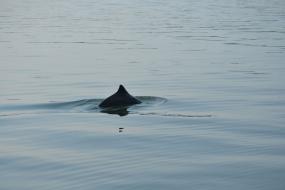
Harbor porpoise in the Salish Sea
In the 1940s, harbor porpoise were among the most frequently sighted cetaceans in Puget Sound, but by the early 1970s they had all but disappeared from local waters. Their numbers have since increased, but they remain a Species of Concern in the state of Washington. This in-depth profile looks at harbor porpoise in the Salish Sea, and was prepared by the SeaDoc Society for inclusion in the Encyclopedia of Puget Sound.
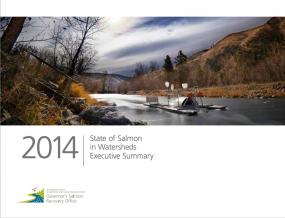
2014 state of salmon in watersheds executive summary
This report documents how Washingtonians have responded to the challenges of protecting and restoring salmon and steelhead to healthy status. It also serves as a tool to summarize achievements, track salmon recovery progress through common indicators, and identify data gaps that need to be filled.
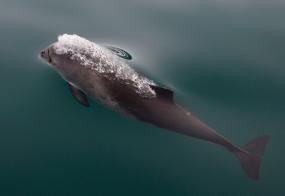
Increased harbor porpoise mortality in the Pacific Northwest, USA: understanding when higher levels may be normal
A 2015 paper in the journal Diseases of Aquatic Organisms examines potential causes of increased harbor porpoise strandings in Washington and Oregon.
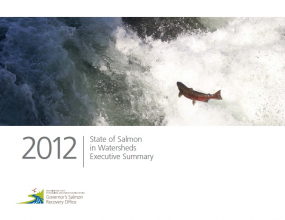
2012 state of salmon in watersheds executive summary
Salmon recovery demands both dedication among people with different interests, and sustained resources. This biennial report tells the story of the progress made to date and the challenges ahead.
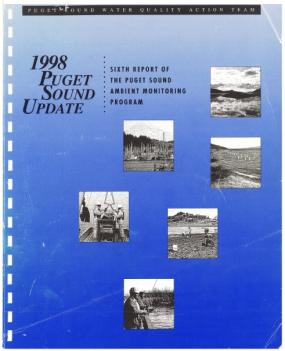
1998 Puget Sound Update
This is the sixth Puget Sound Update, a report for residents of the region about the overall health of Puget Sound. The conclusions in the Update are based mainly on scientific results of the Puget Sound Ambient Monitoring Program (PSAMP).
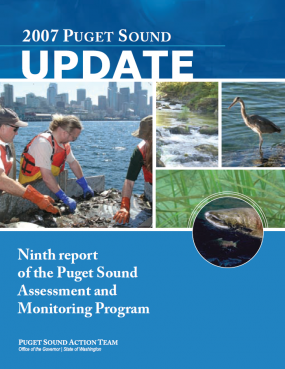
2007 Puget Sound Update
The Puget Sound Update is a technical report that integrates results of PSAMP and other scientific activities in Puget Sound focused on marine life and nearshore habitat, marine and freshwater quality, and toxic contamination.

Puget Sound's Health 2000
This is the Puget Sound Water Quality Action Team’s second report on key indicators of Puget Sound’s health. This report has been prepared in response to the Washington State Legislature’s request to evaluate efforts to protect Puget Sound. This second report includes updated information on the 12 indicators originally presented in 1998 as well as information on five new indicators.
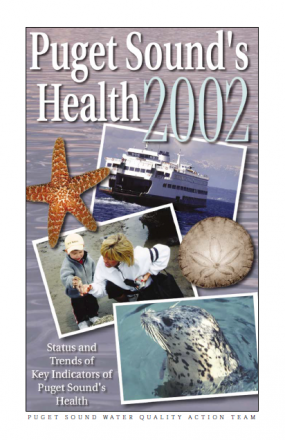
Puget Sound's Health 2002
This is the Puget Sound Water Quality Action Team's third report on key indicators of Puget Sound's Health. We prepared the report in response to the Washington State Legislature's request to evaluate efforts to protect Puget Sound. The report includes updated information on the 17 indicators presented in 2000 as well as information on two new indicators.
Monitoring for adaptive management: status and trends of aquatic and riparian habitats in the Lake Washington/Cedar/Sammamish watershed (WRIA 8)
King County conducted physical and biological monitoring between 2010 and 2013 in the Lake Washington/Cedar/Sammamish (WRIA 8) watershed using common survey protocols and a probabilistic survey design. Hydrologic monitoring was also conducted at several locations to supplement physical and biological monitoring.
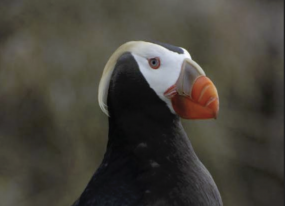
Tufted Puffin (Fratercula cirrhata)
With its striking plumage and brilliant orange bill, the Tufted Puffin is an iconic seabird well known to native peoples, fishermen, and coastal communities throughout its range in the temperate and sub-arctic North Pacific. Though pelagic in winter, puffins gather on islands and headlands during spring and summer to breed and raise their young. They are members of the auk family, with stocky bodies adapted to “flying” underwater as they dive in pursuit of a wide range of fish and invertebrate prey. Nesting Tufted Puffins range up to 100 km from their breeding colonies to forage for their nestlings, and are famed for carrying 20 or more small fish at one time, neatly lined up and carried crosswise in their large, brightly colored bills.
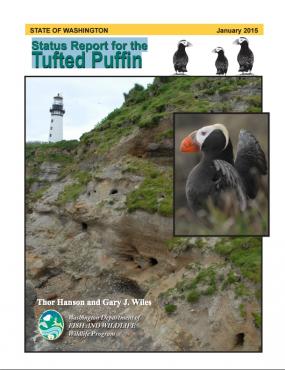
State of Washington status report for the tufted puffin
A 2015 report from the Washington Department of Fish and Wildlife reviews information relevant to the status of the tufted puffin in Washington and addresses factors affecting this status.
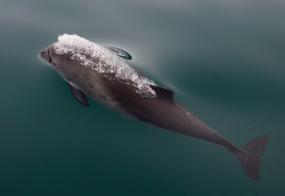
Living in the fast lane: rapid development of the locomotor muscle in immature harbor porpoises (Phocoena phocoena)
A study in the Journal of Comparative Physiology shows that muscle development necessary for diving can take several years to mature in harbor porpoises. Scientists argue that this may make immature harbor porpoises more vulnerable than adults to impacts from boat traffic or other disturbances.

Using stakeholder engagement to inform endangered species management and improve conservation
A 2015 paper in the journal Marine Policy examines surveys of Puget Sound anglers to provide baseline information related to rockfish conservation.
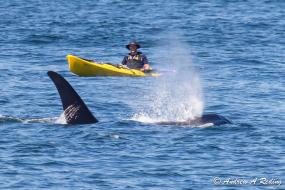
Stimulus-dependent response to disturbance affecting the activity of killer whales
A 2015 paper presented to the International Whaling Commission compares the impacts of kayaks and powerboats on killer whale populations.
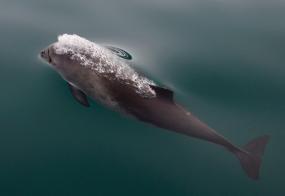
Population structure and intergeneric hybridization in harbour porpoises Phocoena phocoena in British Columbia, Canada
A 2014 paper in Endangered Species Research suggests that harbour porpoises inhabiting coastal waters of southern British Columbia constitute a single genetic population, which should be reflected in management decisions.
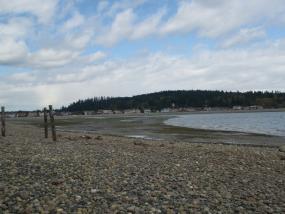
Shellfish restoration and protection in Kitsap Public Health District
A 2014 report by the Kitsap Public Heath District describes the goals and achievements of the Shellfish Restoration and Protection Project including: increasing harvestable shellfish growing areas, establishing a routine shoreline monitoring program, improving water quality, and increasing education of water quality and shellfish protection.
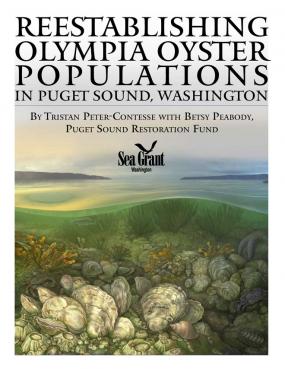
Reestablishing Olympia oyster populations in Puget Sound, Washington
A 2005 report from the Washington Sea Grant Program describing the history and current state of native Olympia oysters including their ecology, history with human interactions, prefered habitat, and reestablishment efforts in the Puget Sound region.
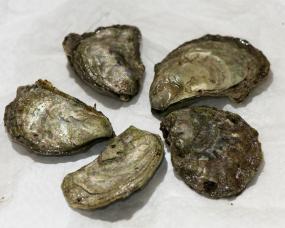
Gifts from the sea: shellfish as an ecosystem service
The region's famed mollusks provide more than just money and jobs. They offer what are called ecosystem services—a wide variety of benefits that humans derive from an ecosystem.
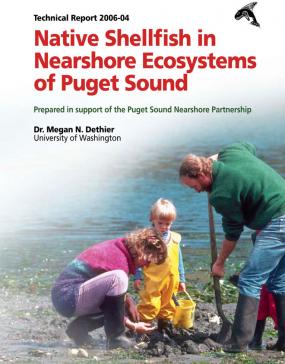
Native shellfish in nearshore ecosystems of Puget Sound
This 2006 technical report for the Puget Sound Nearshore Partnership describes how shellfish have high ecological, economical, cultural, recreational value, however human activity is threatening their existence by altering their native habitat with changes in land use, shoreline modifications, stormwater, sewage and industrial discharge.

Nature inspires new approach to flood control
Scientists are rethinking floodplain management in Puget Sound. Can we have our farms and salmon too?
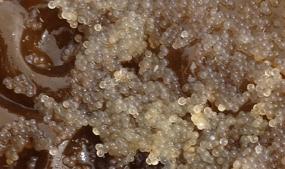
Habitat limitation and spatial variation in Pacific herring egg survival
Puget Sound herring reproduction is not limited by the amount of suitable spawning vegetation, according to a November 2014 paper in the journal Marine Ecology. The article points to terrestrial or marine variables as likely determinants of egg loss.

Seeking higher calories for Puget Sound killer whales
A 2014 paper decribes how monitoring the energy density of key Pacific salmon species could affect the recovery of northern and southern killer whales through fisheries management.
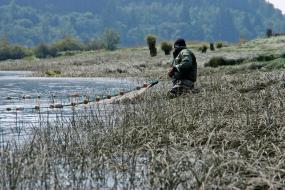
Monitoring and adaptive management of the Nisqually Delta after tidal marsh restoration: Restoring ecosystem function for salmon
This 2009 report by the Nisqually Tribe establishes key measures of restoration development, habitat processes, and Chinook salmon response for the largest delta restoration project in the Pacific Northwest.
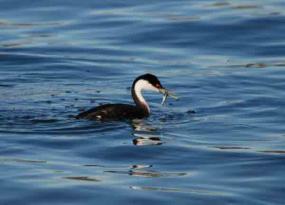
Assessing ecological correlates of marine bird declines to inform marine conservation
Birds that dive for fish while wintering in the Salish Sea are more likely to be in decline than nondiving birds with less specialized diets, according to a 2014 study led by the School of Veterinary Medicine at the University of California, Davis. The study, published in the journal Conservation Biology proposes that long-term changes in the availability of forage fish are pushing the declines.
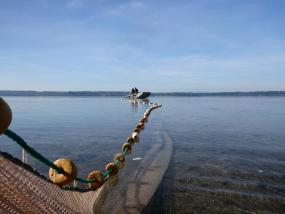
No salmon left behind: The importance of early growth and freshwater restoration
The growth and survival of young salmon in streams, river deltas and floodplains are seen as crucial pieces of the salmon recovery puzzle. In part two of this two-part series, researchers at the Salish Sea Ecosystem Conference in Seattle say the complexities of the salmon life cycle require new coordination among scientists.
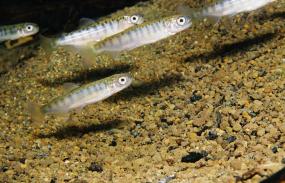
What is killing young salmon in Puget Sound?
Scientists say Puget Sound’s salmon are dying young and point to low growth rates in the marine environment as a possible cause. In part one of this two-part series, scientists consider threats facing young salmon in the open waters of Puget Sound.
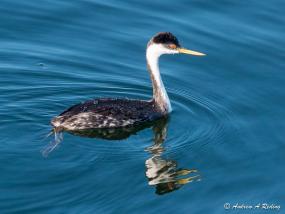
Declines in marine birds trouble scientists
Why did all the grebes leave? Where did they go? And what does their disappearance say about the health of the Salish Sea? Seasonal declines among some regional bird species could hold important clues to the overall health of the ecosystem.
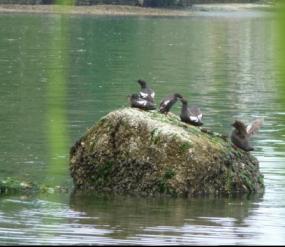
Pigeon Guillemot Foraging and Breeding Survey in and Near the Nisqually Reach Aquatic Reserve
A 2014 report describes a research and monitoring study of Pigeon Guillemot conducted in and near the Nisqually Reach Aquatic Reserve.
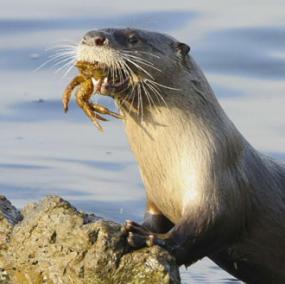
Spatial and Temporal Variation in River Otter (Lontra canadensis) Diet and Predation on Rockfish (Genus Sebastes) in the San Juan Islands, Washington
A 2014 paper in the journal Aquatic Mammals examines coastal river otter predation on rockfish at three islands in the Salish Sea.
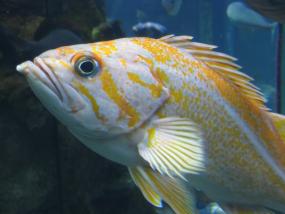
Species of Concern within the Salish Sea nearly double between 2002 and 2013
Approximately every two years, the SeaDoc Society prepares a list of species of concern within the Salish Sea ecosystem. The following paper found 119 species at risk and was presented as part of the proceedings of the 2014 Salish Sea Ecosystem Conference, April 30 – May 2, 2014, Seattle, Washington.
Statement on Salish Sea Harbor Porpoise Research and Management Needs
Harbor porpoise (Phocoena phocoena) are one of the most frequently sighted cetaceans in the Salish Sea. Anecdotal information, possibly supported with stranding encounter rate data, suggests that harbor porpoise may have increased in Puget Sound, or have shifted their distribution back to Puget Sound relative to earlier decades.
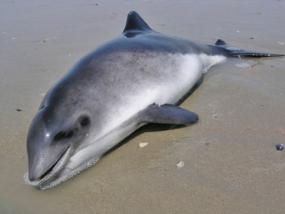
Harbor Porpoise (Phocoena phocoena vomerina): Washington inland waters stock
Harbor porpoises were once common in Puget Sound, but had all but disappeared from local waters by the 1970s. Regular and numerous anecdotal sightings in recent years show that populations of these cetaceans are now increasing and may be approaching their former status. The attached document from NOAA Fisheries describes harbor porpoise numbers and their geographic range in Puget Sound as of 2011.
HARBOR PORPOISE (Phocoena phocoena vomerina): Washington Inland Waters Stock (NOAA Fisheries 2011)
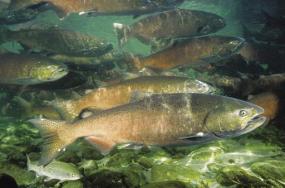
Lead Entities for salmon recovery in Puget Sound
Lead Entities are local organizations in Puget Sound that develop salmon recovery strategies and priorities for the region on a watershed-based scale.
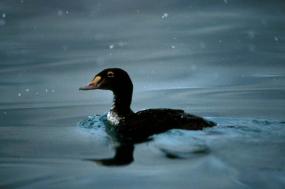
Marine and terrestrial bird indicators for Puget Sound
A December 2013 report identifies marine and terrestrial bird species for use as indicators within the Puget Sound Partnership's "Vital Signs" for ecosystem health.
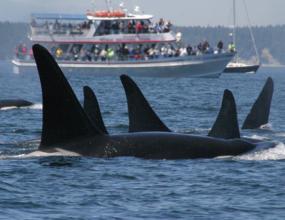
NOAA's draft guidance for assessing the effects of anthropogenic sounds on marine mammals
In December 2013 NOAA released what it classifies as a "Highly Influential Scientific Assessment" of the effects of anthropogenic sound on marine mammals. The comment period on the draft assessment extends until March 13, 2014.
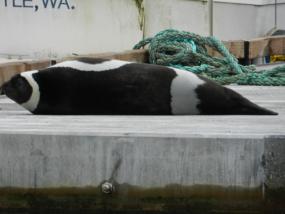
Ribbon seals in the Salish Sea?
Can Puget Sound claim a new species? Ribbon seals were not previously thought to venture into the Salish Sea, but a series of sightings in Puget Sound in 2012 expands their potential range. Scientists are keeping an eye out for future sightings.
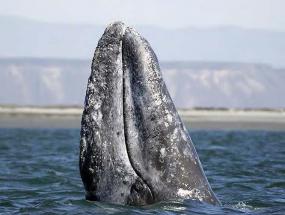
Gray Whale (Eschrichtius robustus)
This article was originally published by the Washington Department of Fish and Wildlife as part of its annual report Threatened and Endangered Wildlife in Washington.
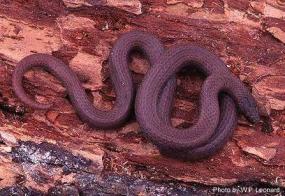
Common Sharp-tailed Snake (Contia tenuis)
This article was originally published by the Washington Department of Fish and Wildlife as part of its annual report Threatened and Endangered Wildlife in Washington.
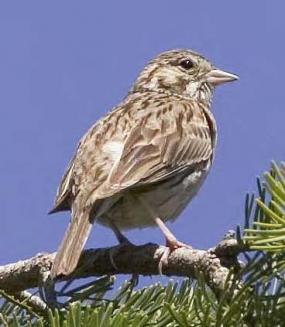
Oregon Vesper Sparrow (Pooecetes gramineus affinis)
This article was originally published by the Washington Department of Fish and Wildlife as part of its annual report Threatened and Endangered Wildlife in Washington.
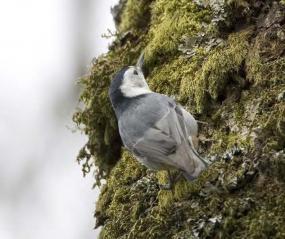
Slender-billed White-breasted Nuthatch (Sitta carolinensis aculeata)
This article was originally published by the Washington Department of Fish and Wildlife as part of its annual report Threatened and Endangered Wildlife in Washington.
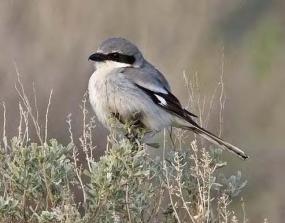
Loggerhead Shrike (Lanius ludovicianus)
This article was originally published by the Washington Department of Fish and Wildlife as part of its annual report Threatened and Endangered Wildlife in Washington.
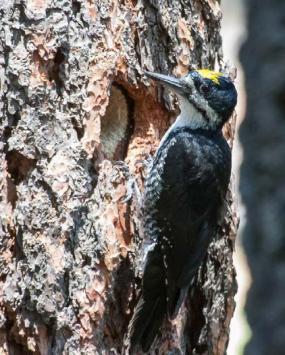
Black-backed Woodpecker (Picoides arcticus)
This article was originally published by the Washington Department of Fish and Wildlife as part of its annual report Threatened and Endangered Wildlife in Washington.
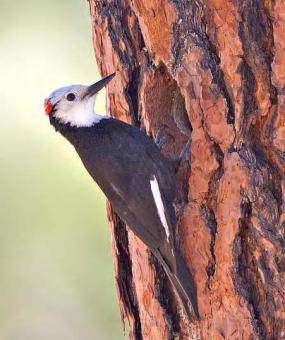
White-headed Woodpecker (Picoides albolarvatus)
This article was originally published by the Washington Department of Fish and Wildlife as part of its annual report Threatened and Endangered Wildlife in Washington.

Vaux's Swift (Chaetura vauxi)
This article was originally published by the Washington Department of Fish and Wildlife as part of its annual report Threatened and Endangered Wildlife in Washington.
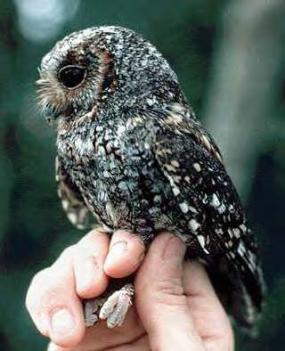
Flammulated Owl (Otus flammeolus)
This article was originally published by the Washington Department of Fish and Wildlife as part of its annual report Threatened and Endangered Wildlife in Washington.
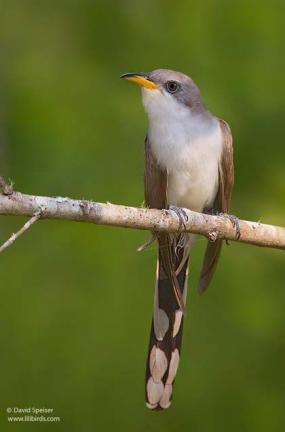
Yellow-billed Cuckoo (Coccyzus americanus)
This article was originally published by the Washington Department of Fish and Wildlife as part of its annual report Threatened and Endangered Wildlife in Washington.
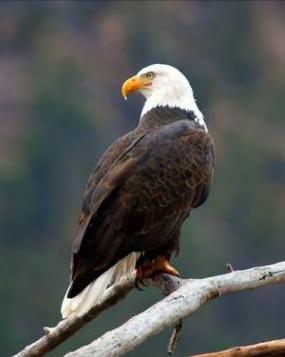
Bald Eagle (Haliaeetus leucocephalus)
This article was originally published by the Washington Department of Fish and Wildlife as part of its annual report Threatened and Endangered Wildlife in Washington.

Newcomb's Littorine Snail (Littorina subrotundata)
This article was originally published by the Washington Department of Fish and Wildlife as part of its annual report Threatened and Endangered Wildlife in Washington.
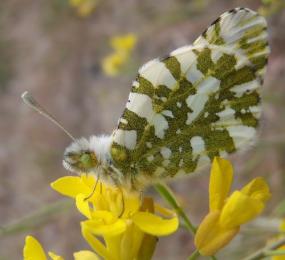
Island Marble (Euchloe ausonides insulanus)
This article was originally published by the Washington Department of Fish and Wildlife as part of its annual report Threatened and Endangered Wildlife in Washington.
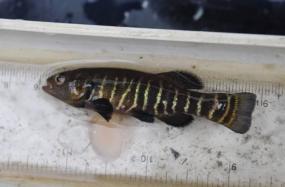
Olympic Mudminnow (Novumbra hubbsi)
This article was originally published by the Washington Department of Fish and Wildlife as part of its annual report Threatened and Endangered Wildlife in Washington.
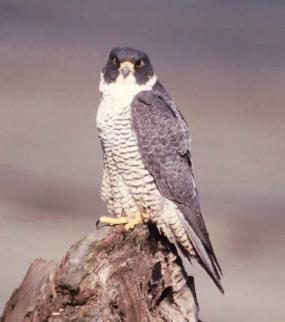
Peregrine Falcon (Falco peregrinus)
This article was originally published by the Washington Department of Fish and Wildlife as part of its annual report Threatened and Endangered Wildlife in Washington

Taylor's Checkerspot (Euphydryas editha taylori)
This article was originally published by the Washington Department of Fish and Wildlife as part of its annual report Threatened and Endangered Wildlife in Washington.
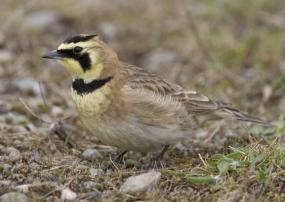
Streaked Horned Lark (Eremophila alpestris strigata)
This article was originally published by the Washington Department of Fish and Wildlife as part of its annual report Threatened and Endangered Wildlife in Washington.
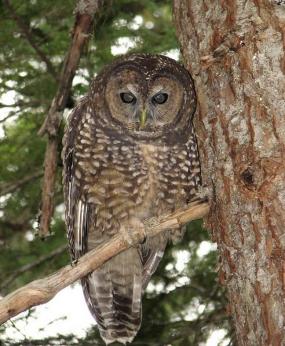
Northern Spotted Owl (Strix occidentalis caurina)
This article was originally published by the Washington Department of Fish and Wildlife as part of its annual report Threatened and Endangered Wildlife in Washington.
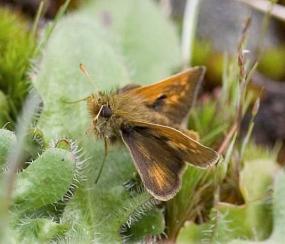
Mardon Skipper (Polites mardon)
This article was originally published by the Washington Department of Fish and Wildlife as part of its annual report Threatened and Endangered Wildlife in Washington.
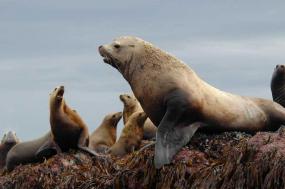
Steller Sea Lion (Eumetopias jubatus)
This article was originally published by the Washington Department of Fish and Wildlife as part of its annual report Threatened and Endangered Wildlife in Washington.
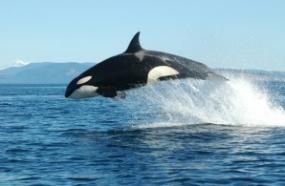
Potential effects of the interaction between marine mammals and tidal turbines – an engineering and biomechanical analysis
A paper presented at the European Wave and Tidal Energy Conference in Aalborg, Denmark describes the potential effects of a tidal turbine strike on an endangered Southern Resident Killer Whale in Puget Sound (SRKW). A tidal turbine is proposed for deployment in Admiralty Inlet in Island County.
Reports: Steller Sea Lion status reports
This page includes documents and links related to the status of Steller Sea Lion in Washington state and the Salish Sea region.
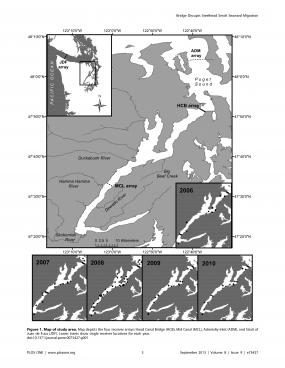
Paper: A floating bridge disrupts seaward migration and increases mortality of Steelhead smolts in Hood Canal, Washington State
A new study provides strong evidence of substantial migration interference and increased mortality risk associated with the Hood Canal Bridge for aquatic animals, and may partially explain low early marine survival rates observed in Hood Canal steelhead populations.
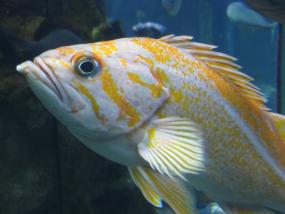
Proposed designation of critical habitat for the distinct population segments of Yelloweye Rockfish, Canary Rockfish, and Bocaccio
The National Marine Fisheries Service has released a Draft Biological Report proposing designation of critical habitat for yelloweye rockfish, canary rockfish, and bocaccio in the Salish Sea. Download the full report and supporting data.
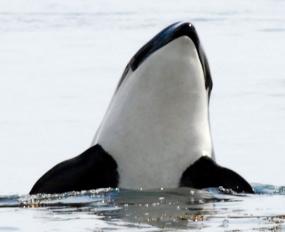
Report: Potential effects of PBDEs on Puget Sound and Southern Resident Killer Whales
The U.S. Environmental Protection Agency Region 10 and the National Marine Fisheries Service Northwest Region have released a report describing results from a series of technical workgroups about the potential effects of polybrominated diphenyl ethers (PBDEs) on Puget Sound and Southern Resident killer whales.
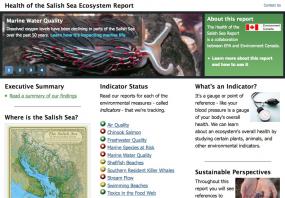
Report: 2013 Health of the Salish Sea Ecosystem Report
The 2013 Health of the Salish Sea Ecosystem Report was prepared jointly by the U.S. Environmental Protection Agency and Environment Canada. View the complete report, or read the Executive Summary below.

Field notes: Are Puget Sound herring limited by loss of eelgrass?
Could recent declines in Puget Sound herring be linked to decreases in native eelgrass? Biologist Tessa Francis reports on a new study that may provide insight into the health of one of the region's most iconic forage fish.
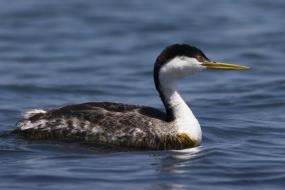
Paper: Citizen science reveals an extensive shift in the winter distribution of migratory Western Grebes
A June 19, 2013 paper in the journal PLoS ONE hypothesizes that regional declines in Western Grebe populations may be related to decreasing numbers of forage fish. Using citizen science data from 36 years of bird counts, researchers were able to look at population trends up and down the entire West Coast, finding that abundance of grebes decreased in the Salish Sea but increased in southern California. North American population declined by 52% overall.
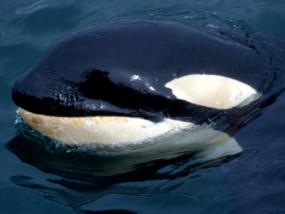
Paper: Spatial and temporal analysis of killer whale (Orcinus orca) strandings in the North Pacific Ocean and the benefits of a coordinated stranding response protocol
A new paper by Puget Sound area scientists from the SeaDoc Society and their collaborators represents the most complete summary to date of killer whale (Orcinus orca) strandings in the North Pacific. The authors analyzed stranding records dating back to 1925, obtained from scientists worldwide, finding that very few whales are stranded (an average of ten a year over the last twenty years). However, most of those strandings result in death. Only 12% of stranded whales survive.
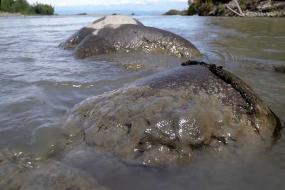
Suspended-sediment concentrations during dam decommissioning in the Elwha River, Washington
This document was prepared by the U.S. Geological Survey in cooperation with the U.S. Environmental Protection Agency and the National Park Service. Download the entire report, or read the Introduction below. Portions of this document were originally published in June 2013 and were updated in February 2014.
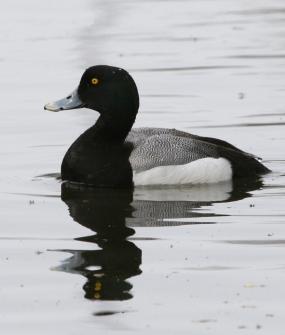
Paper: The incidental catch of seabirds in gillnet fisheries— A global review
Seabird populations are declining worldwide. This paper looks at the impact of gillnets on bird populations.
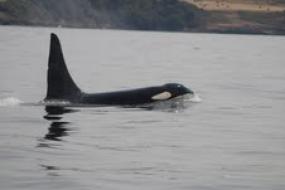
Report: Washington State status report for the Killer Whale
This 2004 report looks at the status of Washington's four killer whale populations.
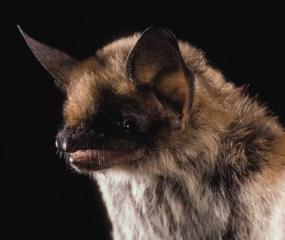
Report: Washington State Bat Conservation Plan
The Washington Department of Fish and Wildlife recently released a Bat Conservation Plan for the 15 species of bats found in Washington State. All but four of these species occur within the greater Puget Sound watershed1, including:

NOAA report establishes Chinook monitoring framework
A new Chinook monitoring framework is designed to build cooperation among managers and policymakers working across the Puget Sound watershed. The report, prepared by an independent team of scientists and released by NOAA, includes a regionally specific, common classification system for Chinook habitats and key ecological attributes.
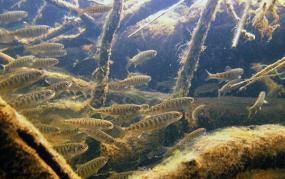
Juvenile Pacific Salmon in Puget Sound
This technical report produced for the Puget Sound Nearshore Partnership on Valued Ecosystem Components (VEC) summarizes existing knowledge of salmon use of nearshore habitats in order to help protect and restore these habitats.
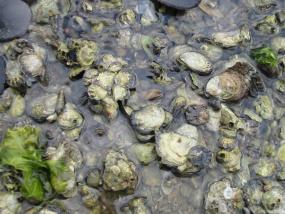
Native shellfish in nearshore ecosystems of Puget Sound
This is the executive summary from a technical report produced for the Puget Sound Nearshore Partnership on Valued Ecosystem Components (VEC). The entire document is included as a PDF with this summary.
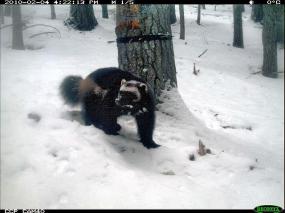
Wolverine (Gulo gulo)
This article was originally published by the Washington Department of Fish and Wildlife as part of its annual report Threatened and Endangered Wildlife in Washington.
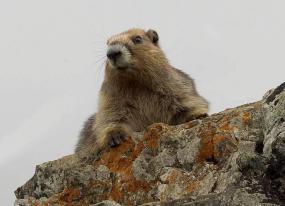
Olympic Marmot (Marmota olympus)
This article was originally published by the Washington Department of Fish and Wildlife as part of its annual report Threatened and Endangered Wildlife in Washington.
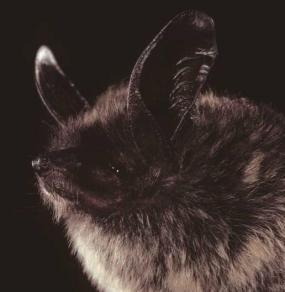
Keen's Myotis (Myotis keenii)
This article was originally published by the Washington Department of Fish and Wildlife as part of its annual report Threatened and Endangered Wildlife in Washington.

Townsend's Big-eared Bat (Corynorhinus townsendii)
This article was originally published by the Washington Department of Fish and Wildlife as part of its annual report Threatened and Endangered Wildlife in Washington.
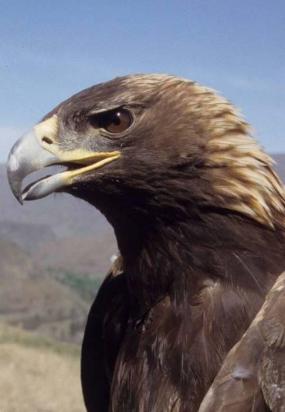
Golden Eagle (Aquila chryseatos)
This article was originally published by the Washington Department of Fish and Wildlife as part of its annual report Threatened and Endangered Wildlife in Washington.
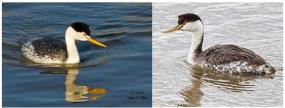
Western and Clark's Grebes (Aechmophorus occidentalis and A. clarkia)
This article was originally published by the Washington Department of Fish and Wildlife as part of its annual report Threatened and Endangered Wildlife in Washington.
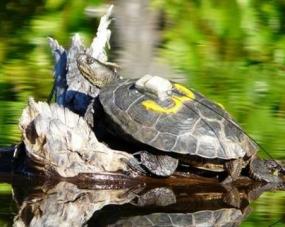
Western Pond Turtle (Actinemys marmorata, formerly Clemmys marmorata)
This article was originally published by the Washington Department of Fish and Wildlife as part of its annual report Threatened and Endangered Wildlife in Washington.
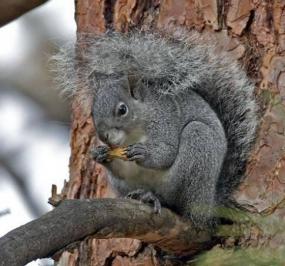
Western Gray Squirrel (Sciurus griseus)
This article was originally published by the Washington Department of Fish and Wildlife as part of its annual report Threatened and Endangered Wildlife in Washington.

Upland Sandpiper (Bartramia longicauda)
This article was originally published by the Washington Department of Fish and Wildlife as part of its annual report Threatened and Endangered Wildlife in Washington.
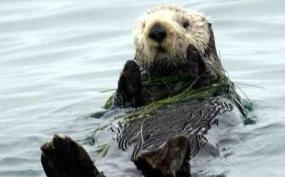
Sea Otter (Enhydra lutris)
This article was originally published by the Washington Department of Fish and Wildlife as part of its annual report Threatened and Endangered Wildlife in Washington.
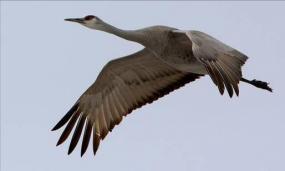
Sandhill Crane (Grus canadensis)
This article was originally published by the Washington Department of Fish and Wildlife as part of its annual report Threatened and Endangered Wildlife in Washington.
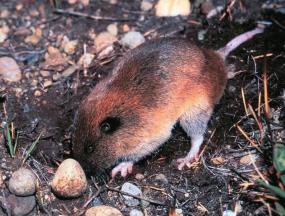
Mazama Pocket Gopher (Thomomys mazama)
This article was originally published by the Washington Department of Fish and Wildlife as part of its annual report Threatened and Endangered Wildlife in Washington.
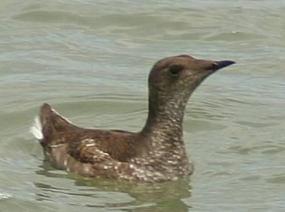
Marbled Murrelet (Brachyramphus marmoratus)
This article was originally published by the Washington Department of Fish and Wildlife as part of its annual report Threatened and Endangered Wildlife in Washington.
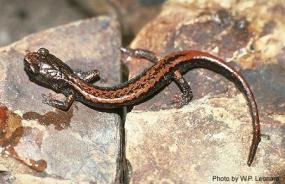
Larch Mountain Salamander (Plethodon larselli)
This article was originally published by the Washington Department of Fish and Wildlife as part of its annual report Threatened and Endangered Wildlife in Washington.
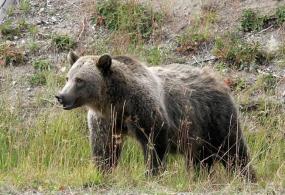
Grizzly Bear (Ursus arctos horribilis)
This article was originally published by the Washington Department of Fish and Wildlife as part of its annual report Threatened and Endangered Wildlife in Washington.
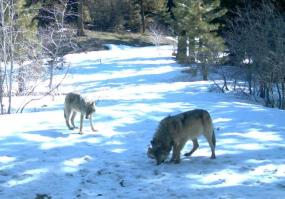
Gray Wolf (Canis lupus)
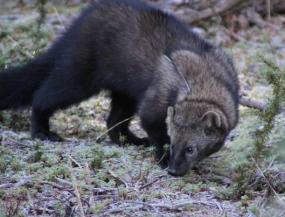
Fisher (Pekania pennanti)
This article was originally published by the Washington Department of Fish and Wildlife as part of its annual report Threatened and Endangered Wildlife in Washington.
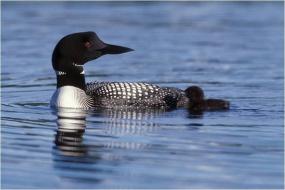
Common Loon (Gavia immer)
This article was originally published by the Washington Department of Fish and Wildlife as part of its annual report Threatened and Endangered Wildlife in Washington.

Brown Pelican (Pelecanus occidentalis)
This article was originally published by the Washington Department of Fish and Wildlife as part of its annual report Threatened and Endangered Wildlife in Washington.
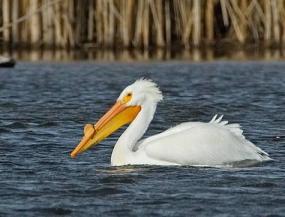
American White Pelican (Pelecanus erythrorhynchos)
This article was originally published by the Washington Department of Fish and Wildlife as part of its annual report Threatened and Endangered Wildlife in Washington.
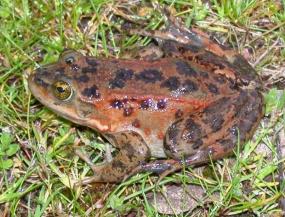
Oregon Spotted Frog (Rana pretiosa)
This article was originally published by the Washington Department of Fish and Wildlife as part of its annual report Threatened and Endangered Wildlife in Washington.
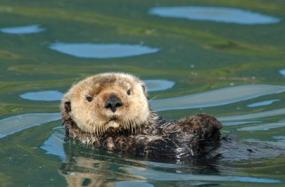
Species of concern in the Salish Sea
The Encyclopedia of Puget Sound species library now includes a list of species of concern in the Salish Sea watershed. The list was created by Joe Gaydos and Jacqlynn Zier of the SeaDoc Society, and was released as a paper presented as part of the Proceedings of the 2016 Salish Sea Ecosystem Conference in Vancouver, BC.

